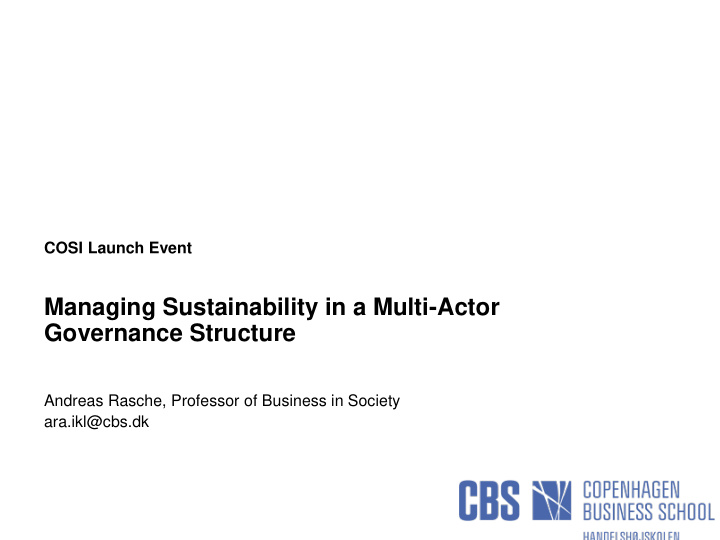



COSI Launch Event Managing Sustainability in a Multi-Actor Governance Structure Andreas Rasche, Professor of Business in Society ara.ikl@cbs.dk 1
The Political Context for Addressing Sustainability 2
Regulating the Global Business Environment Extraterritorial Regulation Self-Regulation Civil Regulation Governments Corporations Corporations Corporations Governments Civil Society Corporations Alien Tort Claims Act Firm-Level Code of Conduct UN Global Compact Hard Law Soft Law 3
The Proliferation of Sustainability Standards 2000 2010 1980 1990 4
Why Do We Have So Many (Competing) Standards? Convergence of Differentiation of Standards Standards Emergence of common Emphasis on distinctive vocabulary features Creation of shared Targeting different groups of ‘certification platforms’ adopters Adoption of industry-level Offering base or premium codes of good practice level 5
What Is the Impact of Sustainability Standards? Government, Civil Society, Peers, Media Supply Adopting Consumer Networks Company Impact on Underlying Sustainability Challenge 6
How Do Sustainability Standards Gain Legitimacy? Inclusion Involvement of stakeholder affected by the issue Input Procedural Fairness Neutralization of power differences Legitimacy Transparency Transparency of structures and processes Coverage Number of firms complying with the rules Output Efficacy Fit of the rules to the respective issue/problem Legitimacy Enforcement Verification of rule implementation 7
What Contributions Can COSI Make? • Measuring (and Quantifying) Impact – fully understanding issues (e.g. biodiversity) in order to better judge the impact of standards; also considering non-linear interaction effects among different issue areas and the dynamics of commensuration • Reaching Beyond the Corporate/Industry Perspective – e.g. how corporate and industry-wide actions affect, and are affected by, planetary boundaries (link ecosystem thinking and corporate sustainability) • Exploring How Successful Collaboration Can Happen – overcoming cultural, cognitive, and institutional barriers; appreciate each other’s knowledge and epistemic approaches; harmonizing evaluation of outlets of scholarly work 8
Recommend
More recommend